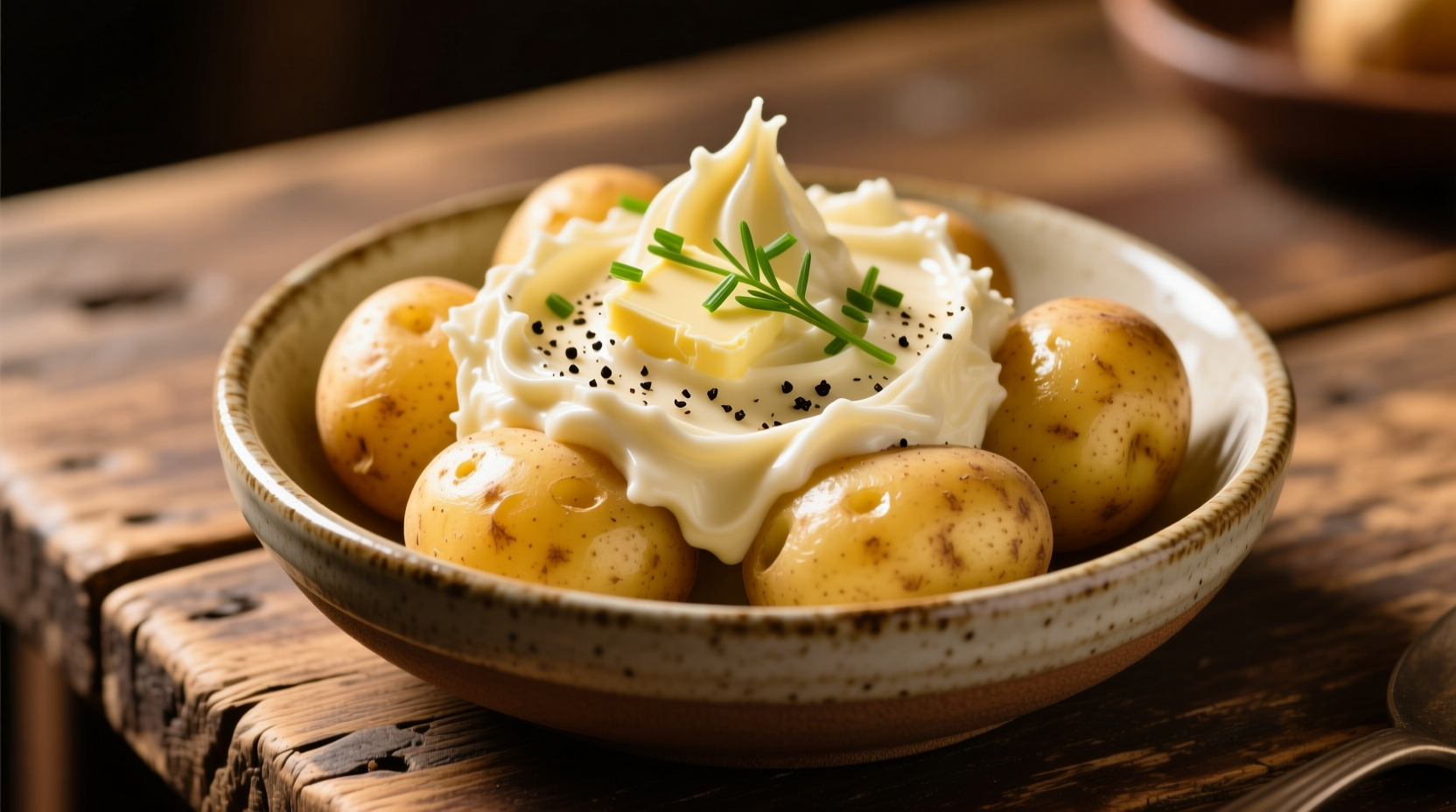Understanding Cream Potatoes: Varieties vs. Preparation
When home cooks search for "cream potato," they're typically seeking either the best potato varieties that deliver naturally creamy results or professional techniques for achieving that luxurious texture. The term doesn't refer to a single specific potato type but rather describes both certain varieties and preparation methods that create that desirable smooth, rich consistency we love in dishes like mashed potatoes, gratins, and soups.
Top Potato Varieties for Creamy Results
Not all potatoes behave the same when cooked. The key to creamy results lies in starch content and moisture levels. Waxy potatoes (like red potatoes) hold their shape well but lack creaminess, while starchy potatoes (like russets) can become fluffy but often dry. The sweet spot for creaminess comes from medium-starch varieties.
| Potato Variety | Starch Content | Creaminess Rating | Best Uses |
|---|---|---|---|
| Yukon Gold | Medium (15-18%) | ★★★★★ | Mashed, soups, gratins |
| Yellow Finn | Medium (14-17%) | ★★★★☆ | Mashed, roasted |
| Russet | High (20-22%) | ★★★☆☆ | Baked, fluffy mashed |
| Red Bliss | Low (12-14%) | ★☆☆☆☆ | Salads, boiling |
This comparison, based on USDA agricultural research data, shows why Yukon Gold consistently outperforms other varieties for creamy applications. Their naturally buttery flesh and balanced starch composition create that signature velvety texture without excessive dairy.
The Science Behind Creamy Potatoes
Understanding potato chemistry transforms your results. When potatoes cook, starch granules absorb water and swell in a process called gelatinization. Yukon Golds reach optimal gelatinization at 140-150°F (60-65°C), creating that perfect creamy consistency. Overcooking causes these granules to rupture, releasing starch that makes potatoes gluey rather than creamy.
Professional chefs at the Culinary Institute of America emphasize that temperature control is critical. "The difference between creamy and gummy mashed potatoes often comes down to just 5 degrees in cooking temperature," explains Chef Thomas Keller in his culinary techniques guide. This explains why many home cooks struggle with texture issues despite using the right potato variety.
Professional Techniques for Perfect Cream Potatoes
Follow these chef-approved methods to guarantee creamy results every time:
Selection and Preparation
- Choose uniform sizes - This ensures even cooking (variations cause some pieces to overcook while others remain hard)
- Soak cut potatoes in cold water for 15-30 minutes to remove excess surface starch
- Cook from cold water - Always start potatoes in cold, salted water rather than boiling to ensure even cooking throughout
Cooking Process
- Bring potatoes to a gentle simmer (not rolling boil) - 180-190°F (82-88°C)
- Cook until fork-tender but still holding shape (typically 15-20 minutes)
- Drain thoroughly and return to warm pot for 1-2 minutes to evaporate excess moisture
Mashing Technique
This is where most home cooks go wrong. The secret to creamy texture without glueiness:
- Use a ricer or food mill instead of blenders or food processors (mechanical action releases too much starch)
- Add dairy at room temperature - Cold dairy causes potatoes to seize up
- Incorporate fats first - Mix butter or cream cheese into potatoes before adding liquid
- Hand-mix gently - Stop as soon as ingredients are incorporated
Avoiding Common Creamy Potato Mistakes
Even with the right potato variety, these errors sabotage creamy results:
Overmixing
Excessive mechanical action breaks down cell walls completely, releasing too much starch. This creates a sticky, glue-like texture rather than smooth creaminess. As culinary scientist Harold McGee explains in On Food and Cooking, "The ideal mashed potato texture occurs when starch granules are swollen but intact."
Incorrect Dairy Temperature
Adding cold dairy to hot potatoes causes temperature shock that makes potatoes seize up and become grainy. Always warm your cream, milk, or butter slightly before incorporating.
Wrong Potato-to-Dairy Ratio
Too much liquid creates soupy potatoes, while too little yields dry results. The ideal ratio is 1/4 to 1/3 cup dairy per pound of cooked potatoes. Yukon Golds require less dairy than russets to achieve creaminess.
Creamy Potato Applications Beyond Mashing
Yukon Gold's natural creaminess shines in various preparations:
Creamy Potato Soup
Use Yukon Golds as the base for naturally thick, velvety soups without heavy cream. Their starch content creates body while their buttery flavor enhances richness. For best results, blend cooked potatoes with just enough broth to achieve desired consistency.
Gratin Dauphinois
When making this classic French dish, Yukon Golds create a creamier texture than traditional russets. Their higher moisture content helps the cream sauce penetrate more effectively during baking.
No-Dairy Creamy Potatoes
For dairy-free options, try these techniques:
- Steam potatoes instead of boiling to preserve more natural starches
- Add roasted garlic or caramelized onions for natural creaminess
- Use potato cooking water as a thickening agent
- Incorporate white beans or cauliflower for added creaminess

Seasonal Considerations for Cream Potatoes
Potato quality varies throughout the year. According to agricultural research from Cornell University's College of Agriculture and Life Sciences, Yukon Golds harvested in late summer through fall offer peak flavor and texture. Winter-stored potatoes often develop sugar conversion issues that affect cooking properties. When selecting potatoes, look for firm, smooth skins without green spots or sprouts.
Storage Tips for Optimal Creaminess
Proper storage maintains the qualities that create creamy results:
- Store in cool, dark place (45-50°F / 7-10°C is ideal)
- Avoid refrigeration which converts starch to sugar
- Keep away from onions which release gases that accelerate sprouting
- Use within 2-3 weeks for best creamy results











 浙公网安备
33010002000092号
浙公网安备
33010002000092号 浙B2-20120091-4
浙B2-20120091-4